.

Director: Gareth Edwards
By Roderick Heath
Compared to the electric expectation stirred by last year’s Star Wars: The Force Awakens, the build-up to the release of Rogue One has felt comparatively muted. Or at least it has to me, because I felt particularly uneasy about what to expect. J.J. Abrams’ reboot for the Star Wars brand was a lovingly-made mediocrity, and seemed to presage a revived Disney-steered series without any boldness or fresh ideas, a bracing new trio of heroes surrounded by efficient but hollow mimicry and Pavlovian responses wrung out through careful employment of beloved fixtures. Rogue One, set between the first two trilogies in George Lucas’s deathless fantasy universe, sports a director and star I felt unsure about and rehashes old territory. Gareth Edwards, a special effects expert turned director, is the helmsman here: Edwards’ Monsters (2010) and Godzilla (2014) were ambitious, impressively mounted attempts to bring anxiety and artistry back to the monster movie genre, but both movies were foiled by Edwards’ unpersuasive dramatic touch.
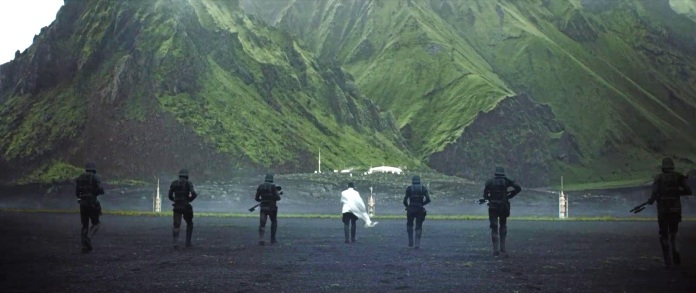
Rogue One had the potential to simply finish up a pile of good-looking spare parts and cheap call-backs for the fan base. Given that I’ve expended a lot of time and effort in the past defining my appreciation for Lucas’ much-derided but substantial and waywardly fascinating, romantically outsized prequel trilogy, I also felt a little threatened by this entry, which seemed poised to be the kind of film those works refused to be. This entry is determined to slavishly recapitulate aspects of Lucas’ 1977 inaugural blockbuster Star Wars – Episode IV: A New Hope, as Rogue One’s narrative quite literally brings us back to the opening seconds of A New Hope. As such it’s an overt work of retro ventriloquism, cloaked in borrowed finery, fan fiction with multimillion dollar heft.

Early signs aren’t greatly encouraging either. Edwards and his duo of very professional, almost overly-competent screenwriters, Tony Gilroy and Chris Weitz, insist on recreating familiar beats for the series barely a year after Abrams did the same on The Force Awakens: thus at the beginning we have another wounded, vengeful young tyro created as the Empire’s violence costs her family members, and leaves her forced to fend for herself. In this case the aggrieved character is young Jyn Erso (Beau Gadsdon), who loses her family as a child, as Imperial commander Orson Krennic (Ben Mendelsohn) arrives on the remote planet to which her father Galen (Mads Mikkelsen) and mother Lyra (Valene Kane) have fled to lead quiet lives as farmers. Galen, a former Imperial officer and scientific genius who was working on the construction of the Death Star, had renounced his work, but Krennic is determined to pressgang him back into service and use his family as leverage. But Lyra is gunned down as she tries to shoot Krennic and the Stormtroopers fail to track down Jyn, who, recalling a foreboding plea of her father’s to remember all his actions are intended to protect her, hides out until located by a friend of her father, the dissident warrior Saw Gerrera (Forrest Whittaker).

Years later, Jyn, having grown into the big-eyed, puffy-lipped form of Felicity Jones, is in an Imperial forced labour camp for incorrigible types. She was raised by Saw but then was suddenly abandoned to drift on the winds of fate, and now she’s an embittered, apolitical survivor and all-round tough cookie. But the Rebel Alliance busts her out of prison and offers her a chance to escape the yoke of law and history. Thanks to the intelligence gathering of hardened Alliance spymaster Cassian Andor (Diego Luna), the Alliance knows that Saw has received a message from Galen, delivered by a former Imperial pilot turned defector, Bodhi Rook (Riz Ahmed), who is currently being brutally interrogated by Saw to ascertain whether he’s a fake or not. Because the Alliance broke off ties with Saw as he drifted into extremism and obsession, they want Jyn to approach him to find out what’s going on. They team her with Cassian and send them to the city of Jedah on a remote planet where the crystals used to power Jedi lightsabers were once extracted: the place has been strip-mined by the Empire for fuel for the Death Star. A Jedi temple used to be located here, and now its scattered caretakers subsist and stir trouble whilst Saw’s adherents fight a guerrilla war with the Imperial soldiers. Jyn and Cassian gain helpmates in two of the former temple caretakers, Chirrut Ïmwe (Donnie Yen), and Baze Malbus (Wen Jiang).

They’re also aided by a reprogrammed Imperial droid, K-2SO (Alan Tudyk). After ambushes and skirmishes in the streets of Jedah, this ragged band is captured by Saw’s fighters and brought to him. In Saw’s company, Jyn is privy to a holographic message from her father brought by Bodhi, in which he explains the flaw he’s laboured to install in the Death Star’s seemingly invincible defences. But Krennic, in command of the now complete and utterly deadly space station, annihilates Jedah and surrounding territory with a shot from its mighty energy weapon, forcing our heroes to flee, except for Saw, who, seeing his labours have found a fitting point of handover, remains to be swept away in the blast. With the proof of her father’s plan lost in the chaos, Jyn immediately faces the problem of attesting Galen’s good faith, a problem that becomes urgent as the Alliance orders Cassian to go to the planet of Eadu where Galen works at an Imperial research facility, and kill him.

I find Rogue One a tricky movie to critique because it stirred many, contradictory reactions in me, simultaneously annoying my critical faculties and getting my blood pumping. Although it bends over backwards to recreate familiar sights and sounds from A New Hope, it also uses that template as an excuse to shift ground just a few inches and avoids leaning too much on the regulation touchstones of the series, like John Williams’ inimitable theme, and the familiar structural conceits like the Star Wars title appearing abruptly on screen, only incorporating such touches when dramatically necessary. Rogue One instead suddenly and jaggedly announces its title, and Michael Giacchino’s score disassembles and refashions elements of Williams’ compositions whilst maintaining their spirit.
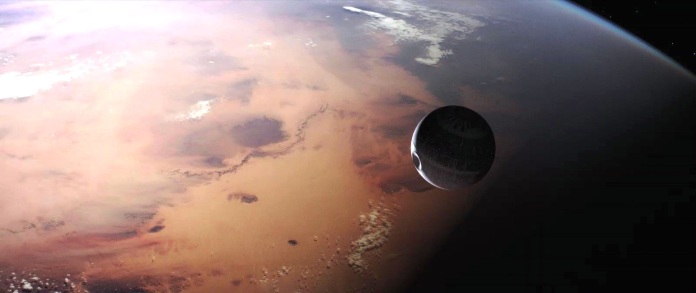
Aspects of Rogue One that fail to live up to the Star Wars legacy also help to make it a slightly more galvanising and vital take on the saga than The Force Awakens. It’s a straightforward war film on most levels, fast-paced, refreshingly hard-edged and ready to go to places on a thematic level the series hasn’t touched on much before, as it emphasises the cumulatively taxing and degrading nature not just of life under tyranny but also of the fight against it. This choice allows Edwards to seek new substance in Lucas’s foundational inspirations, the side of Star Wars that was rooted in action-adventure films set during World War 2, particularly adaptations of Alistair Maclean like The Guns of Navarone (1961) and Where Eagles Dare (1968) and some older models like The Adventures of Tartu (1942), Secret Mission (1943), and The Dam Busters (1956). Aspects of the plot are so hallowed in the history of spy adventures that David and Jerry Zucker and Jim Abrahams’ great 1984 genre lampoon Top Secret! had basically the same storyline. The zesty, fairytale aspect of Lucas’ original creation has been largely suppressed here; so to has its greater conceptual scope and mythopoeic edge.
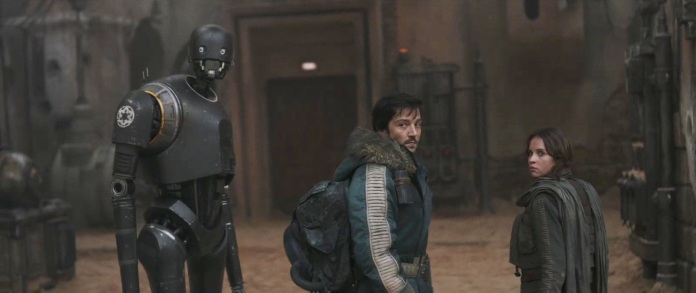
The stolidness of Gilroy and Weitz’s script isn’t entirely papered over by Edwards’ pacing and graphics, either. Gilroy’s a master of modern Hollywood’s programmatic story beats and a crinkle-browed idea of pop seriousness – witness his overrated thriller Michael Clayton (2007), which gave a coat of varnish to a mass of old furniture – whilst Weitz, though better known for comedies, directed the poky but weirdly likeable steampunk fantasy The Golden Compass (2007). That film’s bombing still seems to rankle Weitz, as he’s tellingly named his spunky heroine’s mother after its spunky heroine. Their script is much safer in affect than the archly stylised ye-olde-speak of Lucas’s prequels, so many will probably think it’s good, but it’s actually littered with thudding lines, and major characters remain fuzzily defined and lacking memorable traits. This serves, in a strange way, to highlight just how classically constructed and patient the original was, with its slam-bang opening quickly segueing into a long, almost shambling first act that put together its story and gave a feel for the predicament of its characters in the face of a galactic-sized struggle: archetypes though they be, one knew exactly who Luke Skywalker, Han Solo, Obi-Wan Kenobi, and the other characters of A New Hope were by the time they left Tatooine and rooted for them, warts and all.

By contrast, Rogue One’s first third is a stuttering engine that takes a long time to get up to speed even as it tries to drive us along breathlessly. We set up not one but two father figures for Jyn, good actors Whittaker and Mikkelsen turning up for a few scant minutes where they provide grizzled gravitas, only then to kill them off for teary pathos. Whereas in A New Hope such losses were rites of passage that mimicked familiar life processes in melodramatic terms, here such deaths serve rather another, blunter purpose, as Jyn’s fate inevitably takes a different turn to Anakin and Luke’s. Similarly, there’s a lack of creativity in the storyline that betrays the filmmakers’ lack of any real immersion in the process of inventing science fiction and fantasy concepts for themselves. Instead, they build up to a big, brash edition one of the essential, tiresome clichés of recent blockbuster filmmaking: the big fight around a great tall structure to try and stop or send some kind of all-important signal. Another telling lack, one carried over from The Force Awakens, is a lack of interest in or delight for the alien, the sense of mischievous invention in creating life forms and worlds. Most of what we get here is just slightly transformed familiarities and a couple of hairy moppets and tentacular things given the odd cutaway shot. Perhaps Lucasfilm’s Disney paymasters are still too antsy about the bombardment Jar-Jar Binks received to venture up this trail, and that’s fair enough, but we’re also being cheated of sequences as great and witty as the tavern sequence of A New Hope or characters as vivid as Yoda, Jabba, and Watto. On-screen casting diversity has become a mantra, and that’s something this entry does well, but diversity of personality and species is drying up quicker than the Salton Sea.
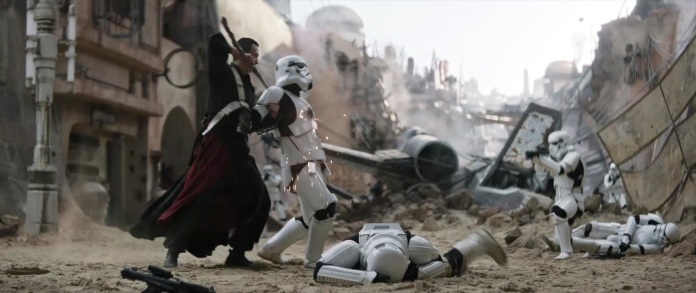
And yet, and yet. To a certain extent the problems of Rogue One cheer me more than The Force Awakens’ relentlessly considered, empty, focus-group-parsed idea of swashbuckling fun. It’s a work fashioned with both finicky attention and messy energy, one that finally gains and maintains real force in spite of all its hoary and lumbering elements. If the Star Wars saga has hitherto represented some surviving stem of the Homeric instinct in western art’s pop culture age, Rogue One is an authentically Euripedean discursion from it – touching base with all the familiar aspects of the mythology but also offering a considered takedown of some of its cherished motifs and a weighing up of what you could call the story behind the myth. Thus what becomes the great stage of heroism for Luke, Han, and Leia is seen to be built on the unstinting determination and sacrifice of others, and whose dedication somewhat ironically contrasts the faltering, Johnny-come-lately attitude of our more familiar champions.
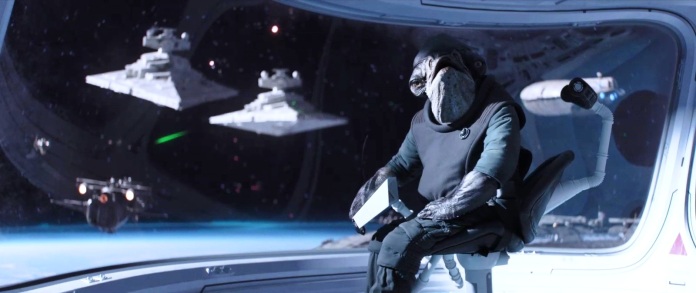
Our protagonists here are all battered outcasts looking for a way to hurt the forces of terror and iniquity as they in turn have been hurt, with Edwards emphasising the atmosphere of the Imperial control as one of general rundown, depression, deprivation and exploitation – notes repeatedly sounded in early scenes as Edwards darts between settings, particularly the grimy, packed, vertiginous environs of a city where Cassian meets with a jittery spy (Daniel Mays). Krennic’s motives are interesting if only sketched, sourced in his faith that the Death Star will finally bring about peace, echoing Anakin Skywalker’s reasons for turning Sith. Rogue One effectively links the original trilogies in both depicting the fallout of one set of events, the breakdown of a society, and setting the stage for a new pivot. Jimmy Smits makes a welcome if unfortunately brief reappearance as Bail Organa, Leia’s adoptive father, alongside Genevieve O’Reilly as Mon Mothma, both in parts they inherited in the prequels as leaders of the Rebels, giving the film a sense of continuity that feels genuinely necessary and cheering.

Much less necessary, even rather ghastly in fact, is the digital simulacrum of Peter Cushing used to represent his role in A New Hope, Grand Moff Tarkin, and, towards the end, of young Carrie Fisher’s Leia. These crappy animations, nominally employed to maintain a sense of immediate continuity, look like something out of a second-rate video game. It’s not even necessary, as O’Reilly’s ease demonstrates. Edwards’ exactitude also stretches less offensively to inserting shots of the some of the actors who play ill-fated X-Wing pilots in the original still in their heyday as hotshots in the Rebel fleet, a much better and salutary touch. Even Darth Vader returns for a couple of scenes to great effect, all his unholy stature, sardonic charisma, and psychopathic force undimmed, initially glimpsed in his private castle set amidst the landscape suggestively reminiscent of the place where he came undone at Obi-Wan’s hands at the end of Revenge of the Sith (2005). Tarkin attempts to lever command of the Death Star out of Krennic’s hands with the justification that Krennic has failed to keep tight security.
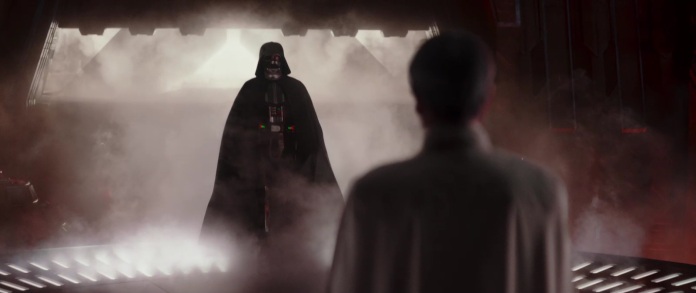
Krennic visits Vader asking him for assurance his achievement will be credited to him and left in his hands, but the Dark Lord is barely interested in Krennic’s egotisms. Krennic also confronts Galen on Eadu, as he perceives Galen’s betrayal. This confrontation coincides with the urgent moment when Jyn tries to reach her father, whilst Cassian wrestles with the choice of obeying orders or helping Jyn to rescue Galen. A flight of X-Wings sent in by the Alliance to make sure of the question unfortunately decides for them, pulverising the facility. The gloss and tactile quality of production that distinguished The Force Awakens has been carried over to this film and perhaps even bettered: Rogue One’s production values are always magnificent, and its special effects never less than persuasive. Better still, Edwards shows that he understands the sense of atmosphere, at once concrete and dreamlike, that is the great saga calling card. This is particularly true during the Eadu attack, filmed in a primal landscape of jutting stony mountains, drenching rain, and glowing technological outposts, the visit to Vader’s castle, places of and bleakly beautiful gothic scale and artisanal intricacy, and the sight of the Death Star in the sky like dawning doom.
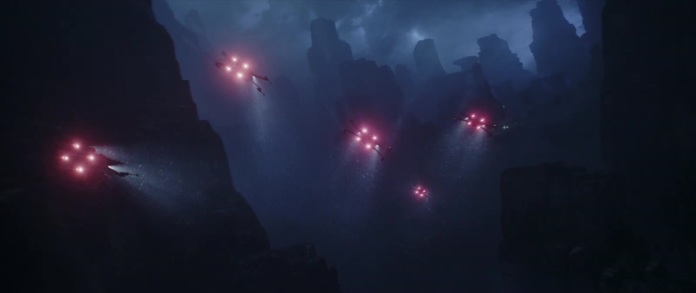
Edwards’ gifts at handling his cinematic canvasses in relation to human-level drama have strengthened, too. On the other hand, so much of the film is dismally underlit and shadowy, just like a few too many recent extravaganzas, affecting moodiness but actually simply trying to cover up any flaws in the effects. It’s telling that the first scene to shock Rogue One to life is one built around a display of physical rather than special effect showmanship, as Yen’s Ïmwe flattens a brace of Stormtroopers armed only with a quarterstaff. Yen’s dashing, lightning-fast moves and good-humoured incarnation of a character obviously inspired by the great Japanese movie hero Zatoichi, and Wiang’s equally fun incarnation of a common type of tough, big-barrel-wielding yeoman common in Chinese action films, gives Rogue One a jolt of authenticity both in the legerdemain on display and the connection to Asian genre film that’s also one of the more notable skeletons in the Star Wars closet. Ïmwe invokes the force throughout and uses it although not with a real Jedi’s competence, but otherwise Rogue One stays true to theme of mystic and spiritual depletion both internal and external that defines the Empire’s reign.
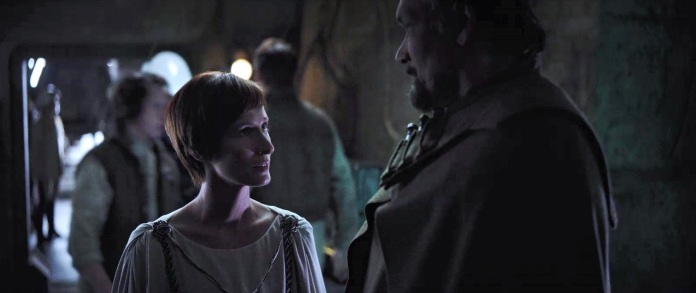
The film’s core dramatic moment comes when Jyn confronts Cassian over his willingness to assassinate her father, and his terse rejection of her harangue, as he’s suffered as much as she has and committed far worse crimes in the name of the Rebellion whilst she’s settled for subsisting on the sidelines. It’s really only here that Jyn and Cassian feel particularly lively as characters, defined by their grazing, mutual sense of righteous anger and defining loss which is of course also complicated by flickers of attraction. Jyn is interchangeable with The Force Awakens’ Rey in too many ways (with dashes of Katniss Everdeen too), to the point where she likewise sets a male counterpart’s eyebrows on high by taking down a few opponents with a stick (c’mon guys, it’s 2016). I don’t much like Jones as an actor and she trades on the same perpetual look of bee-stung hurt that got her through The Theory of Everything (2014) here: Jyn could have been a galvanising heroine but between the non-committal writing and Jones’ lack of effective pith or convincing aggression she remains essentially a placeholder protagonist in spite of the wrenching defining trauma she’s burdened with.
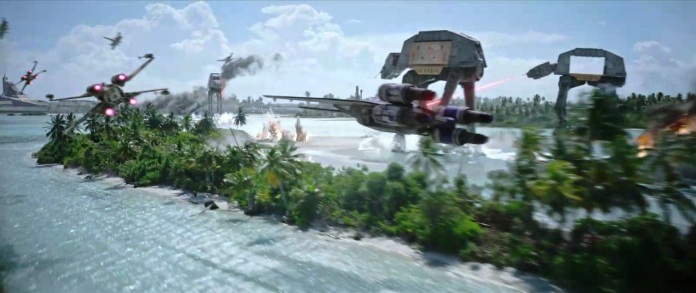
Cassian isn’t much more noteworthy, not given any signature moment or quality, although Luna inhabits him with an effective blend of wiry intensity and quiet unease. In this regard Rogue One is something of an inverse of The Force Awakens, which had fun heroes but too often left them without really cool and interesting things to do. It’s more the characters that surround the central duo that keep things lively here: Ïmwe and Malbus, the abused and apprehensive yet determined Bodhi, and the droll comic relief of K-2SO, whose shtick isn’t terribly original – the obliviously inappropriate sidekick business was already covered in a different key by Guardians of the Galaxy’s (2014) Drax – but it’s still pretty good, thanks to one-time Serenity costar Alan Tudyk’s vocal delivery.
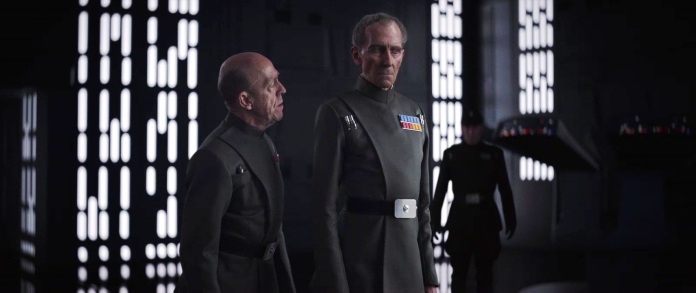
The earthy aspect to the action and the insistent edge of reckoning with the cost of great and calamitous warfare also gives the film ballast painfully lacking from The Force Awakens even as it retards the high spirits and breadth of vision Star Wars calls to mind. The film has an idea, that violence even in the service of a good cause isn’t great for the soul and that some causes are nonetheless more important than individual expectations, which means that it has something its predecessor didn’t have. That idea is also rooted in contradictory impulses and views of the same urge, which makes it similar to the conceptual schism that defines Lucas’s prequels: what if the thing you most want to do, nay, must do, is also the thing that destroys you? Rogue One emphasises the Rebel Alliance not as unstinting paladins but as a coalition of not-quite-aligned interests in a state of flux trying to elide outright confrontational warfare for good reason, engaged in a down-and-dirty conflict played out through more personal acts of violence over pieces of information. The reality of the Death Star suddenly and dramatically changes the landscape, forcing decisions and forging new alliances. In turn, Jyn and her new companions, including more Rebels eager for a chance to make a real difference, go, err, rogue and force their leaders’ hands by making a bold incursion at the Imperial archive centre to steal the Death Star’s plans on the planet Scarif.
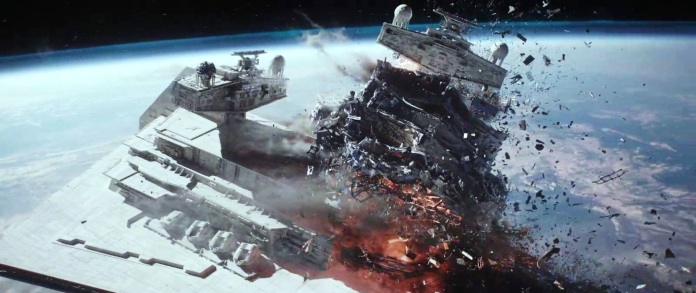
Another lack apparent here, shared with The Force Awakens, is a failure to understand what made the action sequences in the original series work. As well as opportunities to incorporate the way-cool, they were structured as little stories in themselves – an aspect they had in common with Lucas’ other great pulp series, the Indiana Jones films, as chains of cause and effect pushed along by the characters’ objectives. Before one memorable aspect of the finale, there’s no ingenuity to the staging of action. There are not one but two scenes here that hinge on Jyn’s ability to climb really high ladders. Excitement! Ïmwe’s first display of prowess is both invigorating but also, frustratingly, connects to nothing else – he doesn’t even fight much in such a manner again. Perhaps that’s why the climb-the-tall-thing finale is so beloved of hack screenwriters at the moment: it entwines stake and endangerment in an obvious manner. But – and this is a major but – once Rogue One finally cuts footloose it offers a grand finale that, for all the hesitations, is still tremendous. Here the film finally gains the lucid sense of grand happenings entwined with acts of personal valiantness that make for a good epic. Edwards doesn’t have Lucas’ sense of widescreen sweep and spectacle, his scene grammar and punctuation more standard and jittery in the modern fashion, but he’s a much better director of action and visual artisan than Abrams.
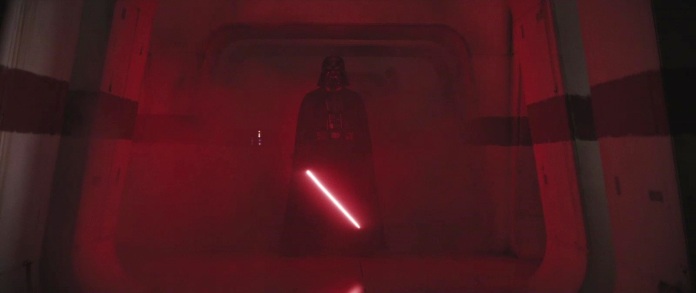
The rogue team’s assault on the Imperial archives draws a portion of the Rebel fleet in their wake for aid, led by Admiral Raddus (Paul Kasey and Stephen Stanton), a spacefaring fighter of the same species as Admiral Ackbar, wielding bravado as he tries to smash through the shield system around the planet to let Jyn transmit the Death Star plans. This sequence is replete with contrivances and clichés, from absurdly placed controls for important pieces of infrastructure to weirdly unsophisticated defence systems for same. But, hell, so are most war films, and at least Edwards and company go for broke and admirably keep to the film’s brief of putting the war in Star Wars, a harum-scarum episode of wildly winging space ships and battling soldiers. Characters die one by one in suitably noble fashions, especially K-2SO, whose act of self-sacrifice is more moving than any of the humans’ deaths, and one which indeed highlights the peculiar approach of the saga to its droid characters, so deeply human as they tend to be in spite of their mechanical and digital natures – indeed, almost hyper-human in their sensitivities and loyalties.
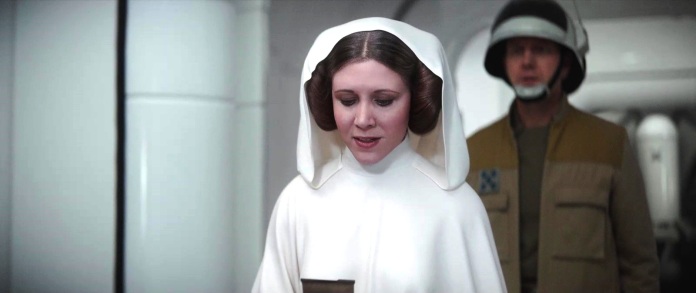
A late shot in the film of two people kissing before an apocalyptic plume about to sweep them away steals a vital image from Paul W.S. Anderson’s Pompeii (2014). There’s great fun in the actual method Raddus and his warriors use to knock out the shield. Best of all, right at the very end, Vader’s return to action, glimpsed a figure of nightmarish evil chasing after the vital copy of pilfered plans and cutting his way through Rebel fighters to get them, the red glow of his lightsaber and his remorseless, unstoppable swathe of violence restoring the unique aura of frightening potency and mystery he wielded when first he advanced into view way back in 1977. Rogue One is definitely a mixed bag and a frustrating experience. But I can at least offer it this much praise: in these scenes, Edwards gets Star Wars thrillingly, uncannily right, and the film’s smash-cut punch-line is perfect.

Wonderful review, Roderick. I also liked this one more than “The force wakens”, overrated.
” but he’s a much better director of action and visual artisan than Abrams.” Perfect.
“A late shot in the film of two people kissing before an apocalyptic plume about to sweep them away steals a vital image from Paul W.S. Anderson’s Pompeii (2014). ”
This passage reminded me of Melancholia (Von Trier).
Congratulations!
LikeLike
“This passage reminded me of Melancholia (Von Trier).”
LOL – well, we all have our different reference points. I found myself mentally trying to track that one and finished up with maybe Terminator 2 (no kiss but similar effect). Anyway, this is definitely a superior popcorn movie even if it’s still not living up to the saga’s higher motifs. Thanks for commenting, Andre.
LikeLike
As always, your Star Wars analysis is spot on. Props for another excellent review (and a phenomenal site in general). Had similar feelings. The first half of the film was a tonally inconsistent muddle, but the final act was the first time I felt these Disney Star Wars films had any life of their own.
As good as Lucas’s six films? Not even close, but at least Rogue One tried to bring something new to the table. That beach scene, as you mentioned, right at the end, was a really pure, beautiful cinematic moment that overcame my post-The Force Awakens cynicism.
LikeLike
Hi Eric. Yep, from now on another year brings another Star Wars film to pick over, it seems. I can’t help but wonder if this one’s comparatively rough critical reception is sourced in belated admission that The Force Awakens did get too much of a free ride. And thanks for the good word about the site in general – ten years just flew by there for me and Marilyn.
LikeLike
Your review misses the whole point of the movie, imho. It is for ten year old kids, to teach them the merits of loyalty and self sacrifice in service of The Greater Good. Watch the WWII claasic, DAYS OF GLORY and join the partisan rebellion against all odds. Hone your skills, find someone to love and die like a hero.
LikeLike
Umm…well, yes, okay.
LikeLike
Actually, Rod, we just finished our 11th year! Holy gee whiz!
LikeLike
Yikes!
LikeLike
Excellent review, Rod. I liked this movie more than you did but I understand where you’re coming from re: the movie’s shortcomings.
I’ve been finding in big spectacle movies like this where there is very little in the script that fleshes out the characters or gives them any kind of depth, the heavy lifting is often left up to the actors to do. I think that’s one of the reasons why THE FORCE AWAKENS engendered such good will – people found Daisy Ridley, John Boyega, et al so charismatic and so inherently likable that they were willing to forgive or overlook the shortcomings in the writing.
I would argue the same applies here. I haven’t seen Felicity Jones in much but I thought she was quite good in this one and her steely determination and personal stakes got me invested in Jyn. And if we know all this about her, the lack of backstory to Diego Luna’s character is what I found so intriguing. He managed to do a lot with the little bits and pieces of character were written for him and then did the rest by how he acted and reacted to those around him. His performance suggested a lot of pain and regret in the past. I thought Luna was very strong.
Anyways, awesome review. I’m surprised you didn’t touch upon the tonal shift of ROGUE ONE and just how bleak and darker it is than any other movie in the STAR WARS franchise – even EPISODE III! It’s interesting to watch ROGUE ONE and then A NEW HOPE right after and it does color your view of the movie.
LikeLike
Hi JD.
Hey, look, I did like this quite a bit and as I thought about it after writing this piece my opinion of it has climbed. That said, I stand by my complaints. I have a thing against Felicity Jones because she was downright bad in The Theory of Everything and yet still got lots of nominations basically because she’s got an English accent. I found her ordinary here too. I’m more on board with you about Luna as he gives the part his all even if it remains very slightly sketched. One thing that was particularly interesting about his role was that he was very close to being a bad guy until love and the pure mission redeemed him – like the secular version of Vader. Perhaps because of the sparseness of their scripted parts neither made as much of an impression as The Force Awakens trio as you say, although I feel this is a considerably superior film to that. As to the question of tone, well, yes, on paper this is sterner stuff than much of the series given that all the main characters die. But they die well all ‘round for a cause we know is going to be justified, and the tone to me was for the most part just full-speed-ahead war movie stuff with a bit of moodiness. Frankly, I don’t think it’s anywhere near as dark and perverse as Revenge of the Sith. Except for that wild concluding sequence of Vader’s rampage. That was some heady stuff.
But anyway, thanks for liking the piece and I’m glad you dug the movie, warts and all.
LikeLike